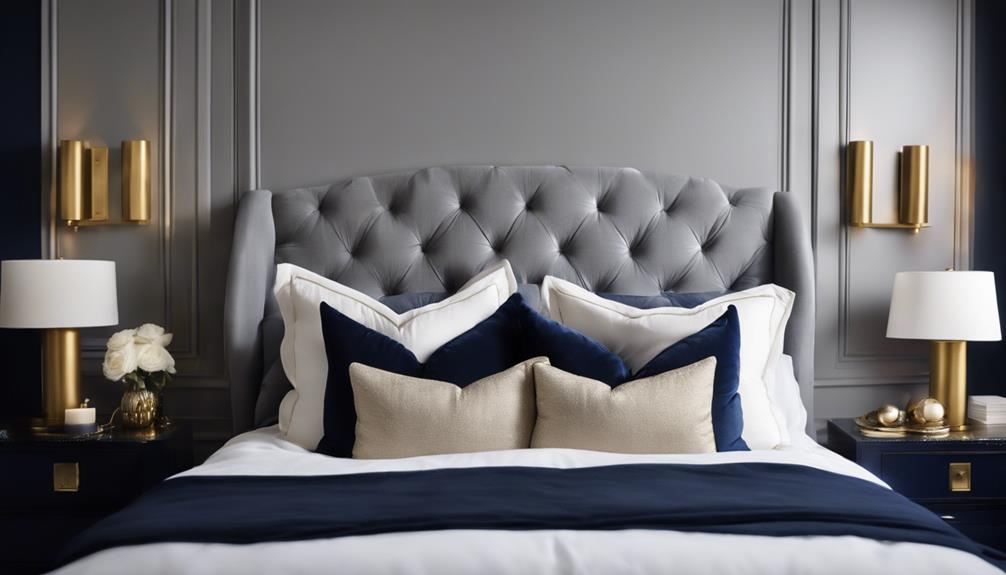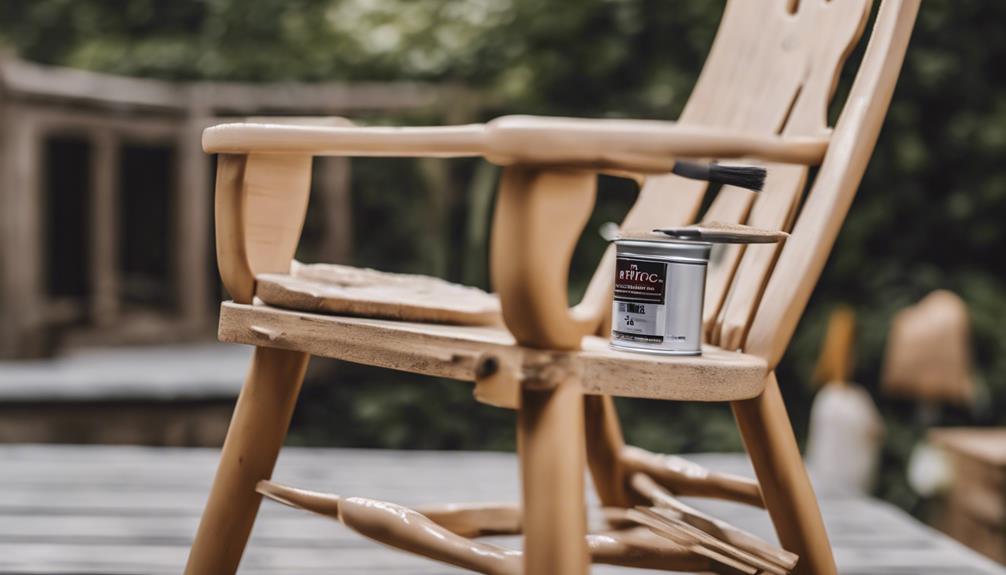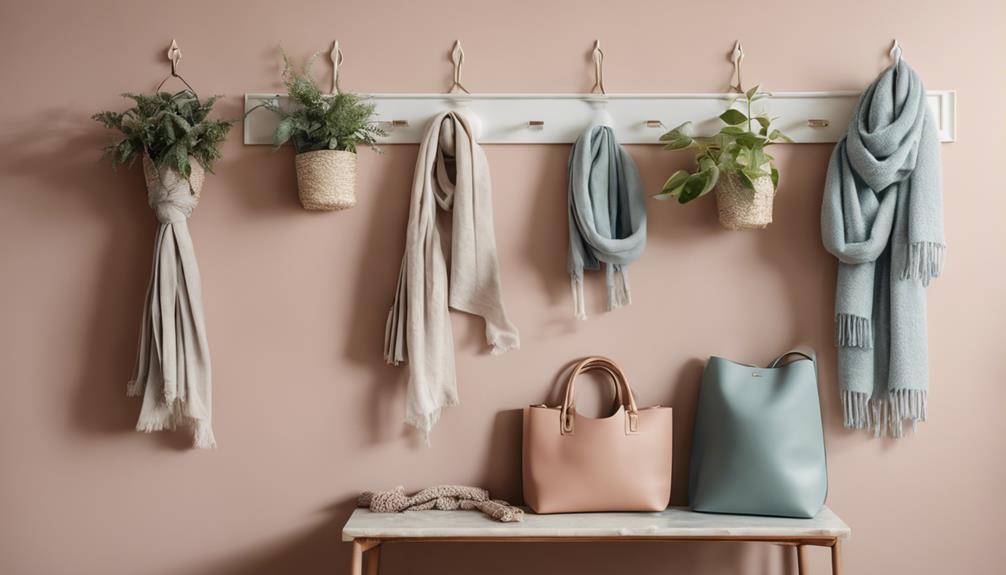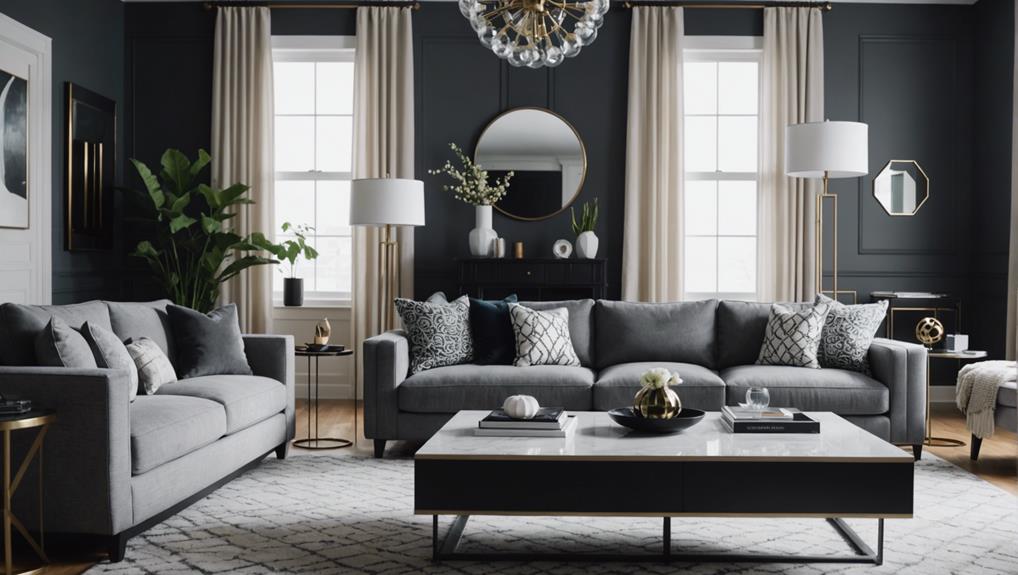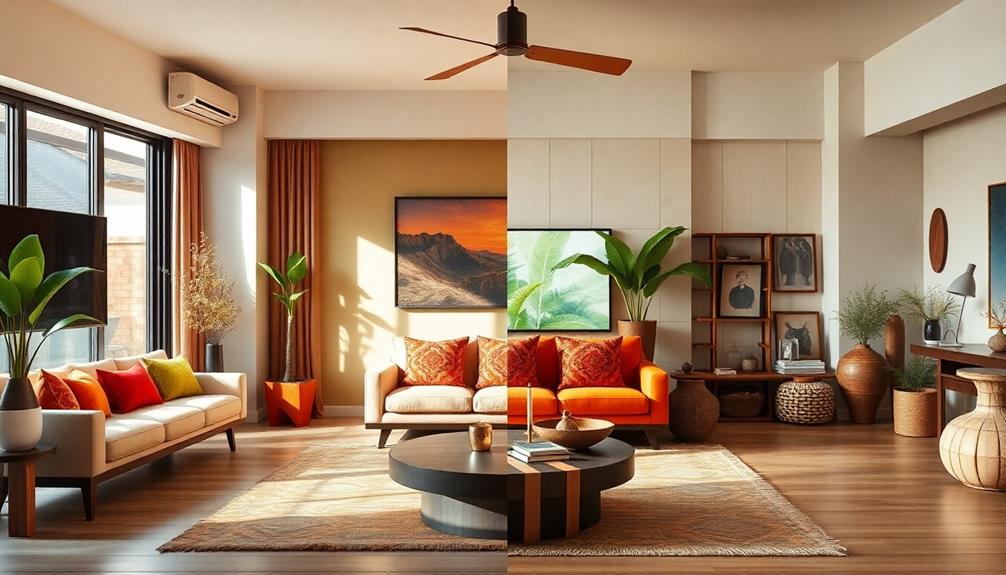To create a show-stopping navy bedroom accent wall, you'll need to combine contrasting textures, metallic accents, and clever lighting placement. Boost visual interest with velvet, linen, or fur textures, and add metallic accents like gold or silver to complement the navy hue. Strategically place lighting fixtures to create pools of light that highlight the wall's richness. Balance the navy with neutrals like white, beige, or gray, and incorporate statement furniture pieces for added visual interest. With these tips, you'll be well on your way to creating a dramatic and inviting ambiance – and there's even more to explore to take your accent wall to the next level.
Key Takeaways
• Boost visual interest by incorporating contrasting textures like velvet, linen, or fur, and metallic accents like gold or silver.
• Strategically place metallic decor pieces, such as frames, mirrors, or light fixtures, to enhance the navy accent wall's aesthetic.
• Balance the navy accent wall with neutrals like white, beige, or gray, and add light-colored furniture to make it pop.
• Create depth and dimension by mixing textures, patterns, and materials, including rough, smooth, and natural elements.
• Use strategic lighting placement, such as above or beside the accent wall, to create dramatic effects and make the navy color pop.
Boosting Visual Interest
To take your navy accent wall to the next level, incorporate a mix of contrasting textures, metallic accents, bold colors, statement furniture, and strategic lighting to create a visually stunning focal point in your bedroom. By combining these elements, you'll create a visually appealing space that draws the eye to your navy accent wall.
Start by introducing contrasting textures like velvet, linen, or fur to add depth to the wall. Next, incorporate metallic accents such as gold or silver to create a glamorous and sophisticated look against the navy backdrop. You can also introduce pops of color like mustard yellow, blush pink, or emerald green to make the navy accent wall stand out even more.
To further enhance the visual interest, include statement furniture pieces like a bold headboard or a unique dresser that draw attention to the navy accent wall. By incorporating these elements, you'll create a stunning focal point in your bedroom that showcases your navy accent wall in the best possible light.
Adding Metallic Accents Wisely
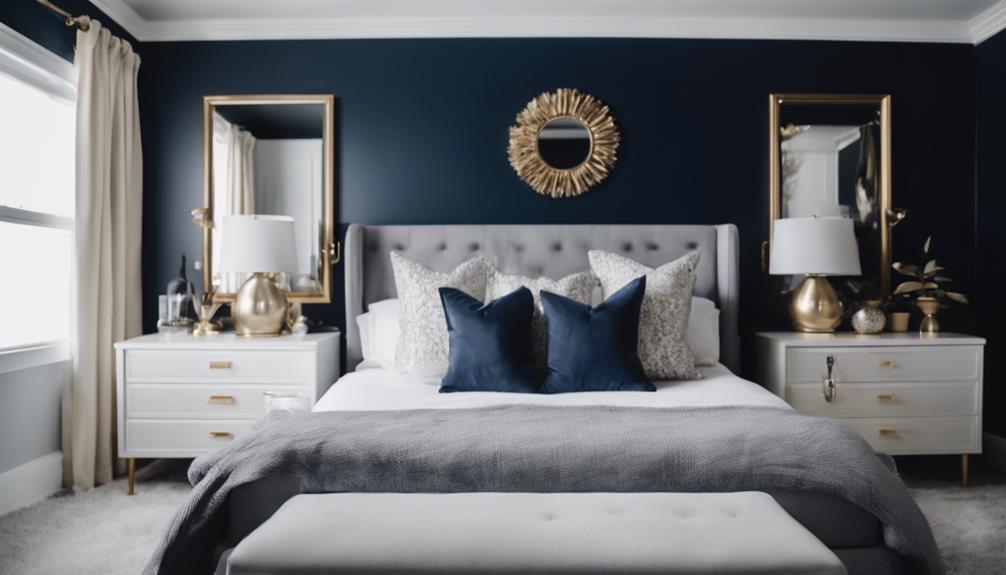
Now that you've boosted the visual interest of your navy accent wall, it's time to add some metallic flair to really make it pop.
You'll want to choose metallic accents that complement the navy hue, and that's where your personal style comes in – will you opt for classic gold, trendy rose gold, or something entirely different?
Metallic Mates for Navy
By pairing navy with metallic accents like gold, silver, or bronze, you can create a sophisticated and luxurious atmosphere in your bedroom. When choosing metallic accents to complement your navy blue paint, remember that balance is key. You don't want the metallic elements to overpower the richness of the navy color. Instead, strategically place metallic decor pieces to enhance the overall aesthetic.
Metallic accents can add a touch of luxury and sophistication to a navy bedroom accent wall, so choose wisely. Consider metallic frames, mirrors, light fixtures, or decorative items to make your navy accent wall pop. The contrast between the deep tones of navy and the shimmering metallic elements will create a visually appealing effect. Gold, silver, and bronze are all excellent options to pair with navy, as they add a touch of glamour and sophistication to the space.
Accenting With Gold
As you consider adding metallic accents to your navy bedroom accent wall, you'll find that incorporating gold elements is an excellent way to introduce a touch of luxury and sophistication, especially when done thoughtfully.
The combination of navy blue and gold creates a warm and inviting atmosphere in the bedroom, making it perfect for a relaxing retreat. By wisely adding metallic gold elements to the navy accent wall, you'll enhance the overall design aesthetic, creating a chic and elegant look in the room.
The richness of navy blue is beautifully complemented by gold accents, which elevate the room's style and create a cohesive design scheme. To achieve a sophisticated look, balance gold accents with navy blue to avoid overwhelming the space. By doing so, you'll create a beautiful, harmonious atmosphere that exudes elegance and refinement.
Rose Gold Delight
When incorporating metallic accents into your navy bedroom accent wall, you'll find that rose gold adds a touch of luxury and sophistication, elevating the overall aesthetic with its warm, subtle tones.
To achieve a balanced look, consider incorporating rose gold decor items like lamps, frames, or vases that complement the cool tones of navy blue. The result is a harmonious blend of warm and cool tones that creates a visually appealing contrast.
Additionally, using rose gold hardware on furniture or light fixtures can tie the room together, adding a subtle pop of color and visual interest to your navy accent wall without overwhelming the space.
Mixing Textures for Depth

As you continue to elevate your navy accent wall, it's time to explore the domain of textures – and we're not just talking about visual interest, but a multi-sensory experience that invites touch and exploration.
By incorporating a mix of textures, you'll create a space that's not only visually appealing but also tactilely engaging.
Now, let's examine the key points to contemplate when mixing textures, including rough texture contrasts, smooth surfaces, and natural elements that shine.
Rough Texture Contrasts
By pairing a rough-textured navy accent wall with smooth furnishings, you create a striking contrast that immediately grabs attention. This contrast adds depth to the room and makes the accent wall a focal point.
To take it to the next level, incorporate elements that enhance the textured look:
- Add a shaggy rug: The soft, plush texture of the rug will provide a cozy feel and create an interesting contrast with the rough wall.
- Incorporate woven baskets: The natural texture of the baskets will add warmth and depth to the room.
- Mix materials: Combine velvet, wood, and metal with the rough texture of the wall for a visually appealing contrast.
- Add textured throw pillows: These will enhance the cozy feel of the navy accent wall and create an inviting atmosphere.
Smooth Surfaces Matter
You can create a sophisticated and inviting atmosphere in your bedroom by incorporating smooth surfaces into your navy accent wall design, which provides a striking contrast to the rough textures explored earlier.
By mixing textures, you can add depth and visual interest to your navy accent wall. Smooth surfaces, such as velvets, linens, and metallics, reflect light differently, creating a dynamic play of shadows on the navy wall.
This textural contrast prevents the navy accent wall from appearing flat and one-dimensional, instead, creating a luxurious and inviting atmosphere in the bedroom. Consider adding elements like mirrors, metallic accents, or glossy finishes to enhance the smooth surface of the navy accent wall.
By incorporating a variety of textures, you can create a visually appealing contrast that draws the eye to the navy accent wall. The key is to balance smooth surfaces with rough textures to achieve a harmonious and sophisticated look.
With smooth surfaces, you can add a touch of elegance and sophistication to your bedroom, making it a relaxing retreat.
Natural Elements Shine
Incorporate natural elements like wood, metal, and natural fibers to add depth and visual interest to your navy bedroom accent wall. By mixing materials, you'll create a visually appealing space that's full of texture and dimension.
Here are some ways to incorporate natural elements into your design:
- Mix materials: Combine a jute rug, a wooden bed frame, and a metal bedside lamp to create a space that's rich in texture and visual interest.
- Add soft fabrics: Use velvet throw pillows or a plush rug to contrast with the boldness of the navy accent wall.
- Bring in greenery: Add plants or botanical prints to bring a pop of color and a natural element to the room.
- Incorporate stone or marble: Consider adding elements like stone or marble to complement the richness of the navy blue accent wall.
Strategic Lighting Placement
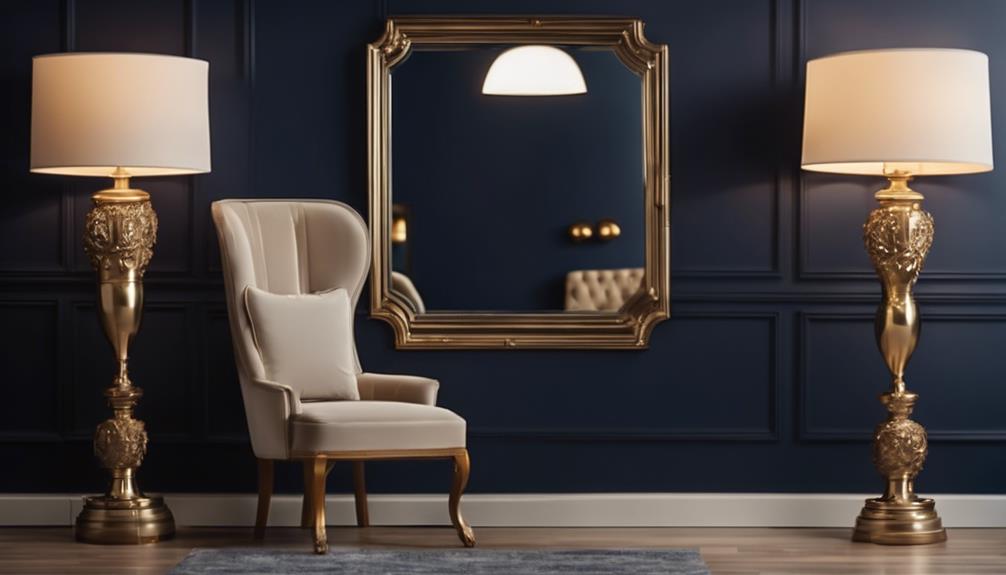
To elevate your navy accent wall, position lighting fixtures strategically to create dramatic effects and accentuate the room's ambiance.
By placing lights above or beside the accent wall, you'll create dramatic shadows and highlights that make the navy color pop.
Consider utilizing warm-toned light bulbs to complement the navy wall, adding warmth and vibrancy to the space.
Additionally, incorporating dimmable lighting options allows you to adjust the brightness to showcase the navy accent wall effectively.
Accent lighting can also be used to highlight artwork or decor on the navy wall, drawing attention and making it stand out in the room.
By strategically placing lighting fixtures, you'll enhance the navy accent wall's depth and richness, creating a dramatic and inviting atmosphere.
Balancing Navy With Neutrals
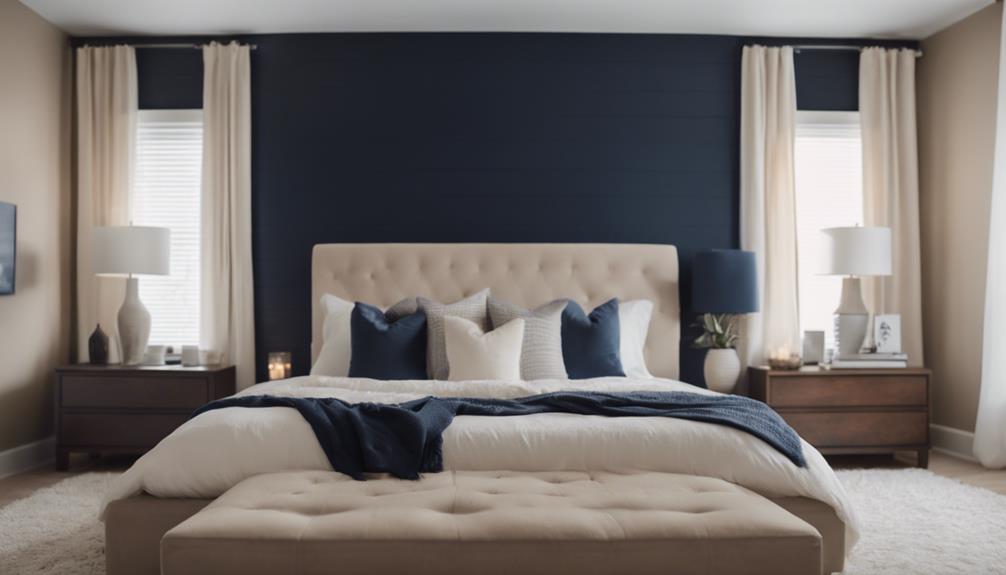
By balancing your navy accent wall with neutral colors, you can create a harmonious contrast that prevents the room from feeling overwhelming. This contrast not only adds visual appeal but also creates a sense of calmness in the bedroom.
To achieve this balance, consider the following:
- Pair navy with neutrals: Combine your navy paint with neutral colors like white, beige, or gray to create a soothing atmosphere.
- Add light-colored furniture: Incorporate light-colored furniture or decor items against your navy accent wall to make it pop.
- Incorporate metallic accents: Add a touch of sophistication with metallic accents like gold or silver to enhance the wall's impact.
- Mix textures: Opt for a mix of textures like velvet, linen, or wood in neutral tones to complement the navy wall and add depth to the space.
Creating Dimension With Patterns
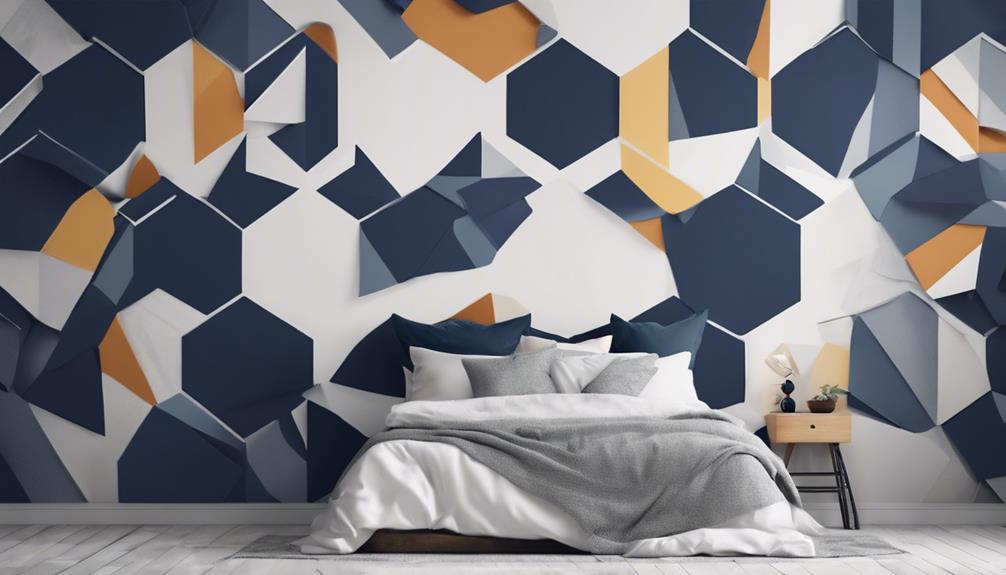
You can add depth and visual interest to your navy accent wall by introducing patterns that create a sense of dimension and style.
Geometric patterns in navy blue are a great way to achieve a modern and dynamic look. Try mixing stripes and chevron patterns to add visual interest and depth to your accent wall.
For a sophisticated and elegant look, consider opting for a herringbone or quatrefoil pattern. If you want to make a statement, go bold with a damask or floral print in navy blue.
Alternatively, experiment with abstract or Moroccan-inspired patterns to infuse your accent wall with personality and style. Remember, the key is to create a sense of dimension and visual interest, so don't be afraid to experiment with different patterns and combinations.
Adding Luxurious Touches
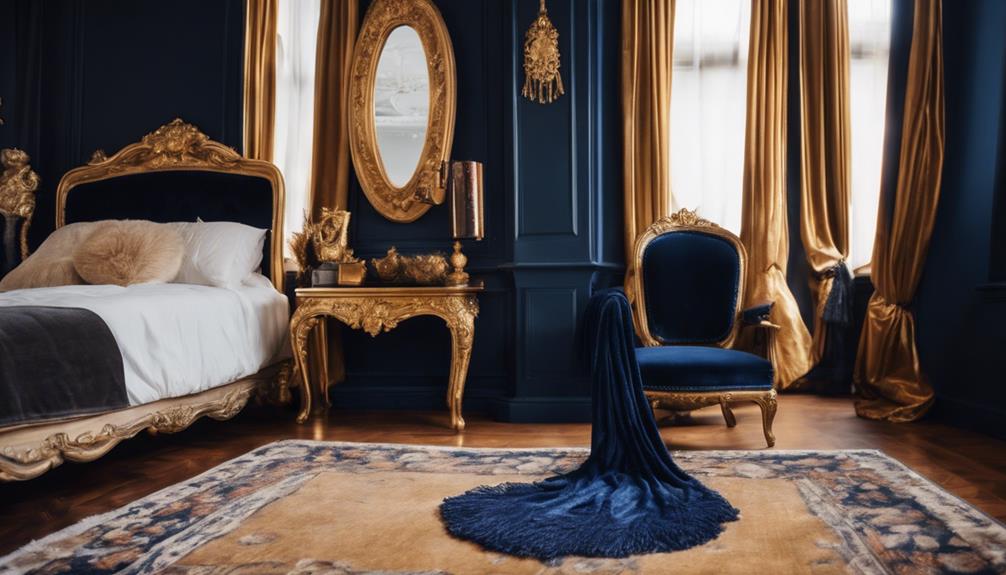
Gold accents, rich textures, and high-quality materials will transform your navy accent wall into a luxurious oasis, perfect for a restful retreat. To take your bedroom to the next level, consider incorporating these luxurious touches:
- Gold Accents: Add frames, mirrors, or light fixtures with gold accents to create a sense of opulence.
- Plush Textures: Choose velvet or silk cushions and throw blankets with rich textures to enhance the luxurious feel.
- Luxurious Bedding: Opt for high-quality bedding with a high thread count and luxurious materials like Egyptian cotton for a sumptuous touch.
- Statement Lighting: Add a statement chandelier or elegant pendant lights to create a glamorous ambiance in the room.
Highlighting the Accent Wall
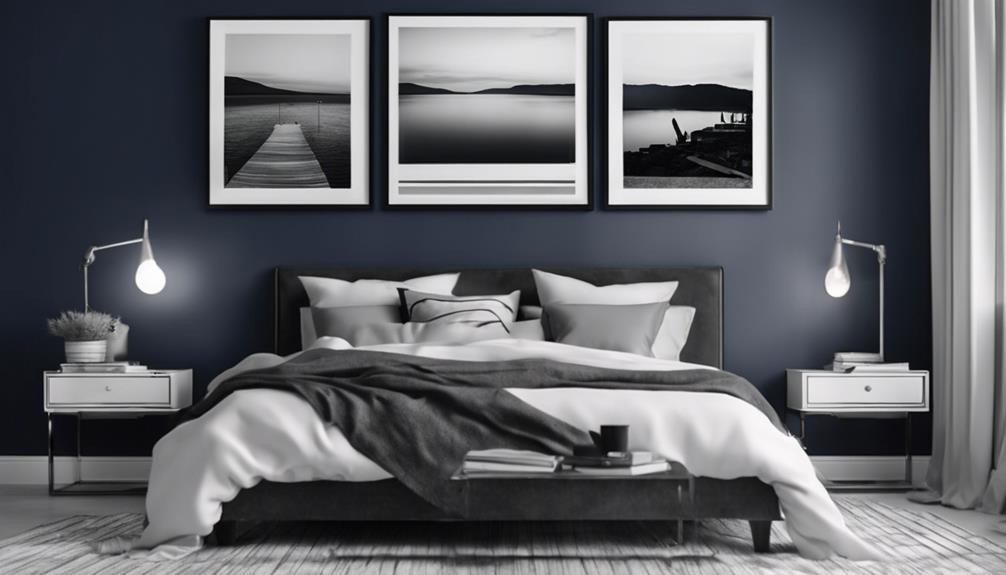
To draw attention to your navy accent wall, strategically place lighting fixtures to create pools of light that highlight its richness. This won't only create depth in the room but also make the navy hue stand out.
By incorporating contrasting decor pieces, such as white or gold frames, you can make the accent wall pop even more. For example, you could hang a white-framed mirror or a gold-framed piece of art above a navy dresser to create a striking contrast.
Additionally, choose complementary colors for your bedding and accessories to enhance the impact of the accent wall. Consider positioning furniture like a statement headboard or a bold piece of art against the navy wall for added visual interest.
Frequently Asked Questions
What Color Goes Best With a Navy Accent Wall?
When choosing a color to pair with a navy accent wall, you have plenty of options.
You might consider classic white, which creates a crisp, timeless look.
Gold accents can add luxury and sophistication, while light gray or silver tones offer a modern contrast.
Warm neutrals like beige or taupe create a cozy atmosphere, and bold colors like mustard yellow or emerald green make a vibrant statement.
Ultimately, the right color for you'll depend on your personal style and the overall aesthetic you want to achieve.
How to Decorate a Navy Blue Bedroom?
As you start decorating your navy blue bedroom, envision yourself walking into a serene retreat.
You've already mastered the accent wall, now it's time to harmonize the rest of the space.
Start by incorporating gold accents, like picture frames or lamps, to add a touch of sophistication.
Then, introduce textures with plush throw pillows, a knit blanket, or a faux fur rug to create depth and visual interest.
How Do I Make My Bedroom Accent Wall Stunning?
When creating a stunning accent wall, you'll want to start with the perfect shade of navy blue. Consider Compass from the Devine collection, which sets the tone for a sophisticated space.
Then, incorporate gold accents to add luxury and elegance. Velvet blue or deep navy walls with gold accents can create a regal ambiance.
What Is the Complementary Color of Navy?
As you explore the world of color theory, envision a canvas of possibilities unfolding before your eyes.
The complementary color of navy, you ask? It's a soft peach or coral, a striking contrast that will make your design pop.
This harmonious pairing will create a visual feast, with the warm, gentle hue of peach or coral beautifully offsetting the cool, dark tone of navy.
Conclusion
By incorporating these design elements, you'll create a navy bedroom accent wall that truly pops.
Did you know that a recent survey found that 65% of homeowners consider accent walls a 'must-have' feature in their ideal bedroom design?
By strategically balancing navy with neutrals, adding metallic accents, and incorporating textures and patterns, you'll create a visually stunning space that exudes sophistication and style.
With these expert tips, you'll be well on your way to designing a bedroom that's both beautiful and Instagram-worthy.
